Strategies for promoting positive behaviour in children and young people
VerifiedAdded on 2023/06/09
|20
|4207
|221
AI Summary
This article discusses various strategies for promoting positive behaviour in children and young people, including establishing ground rules, managing inappropriate behaviour, and identifying triggers for inappropriate behaviour. Real-life examples are provided to illustrate the effectiveness of these strategies.
Contribute Materials
Your contribution can guide someone’s learning journey. Share your
documents today.

Running head: POSITIVE BEHAVIOUR
Positive behaviour
Name of the student:
Name of the University:
Author note:
Positive behaviour
Name of the student:
Name of the University:
Author note:
Secure Best Marks with AI Grader
Need help grading? Try our AI Grader for instant feedback on your assignments.
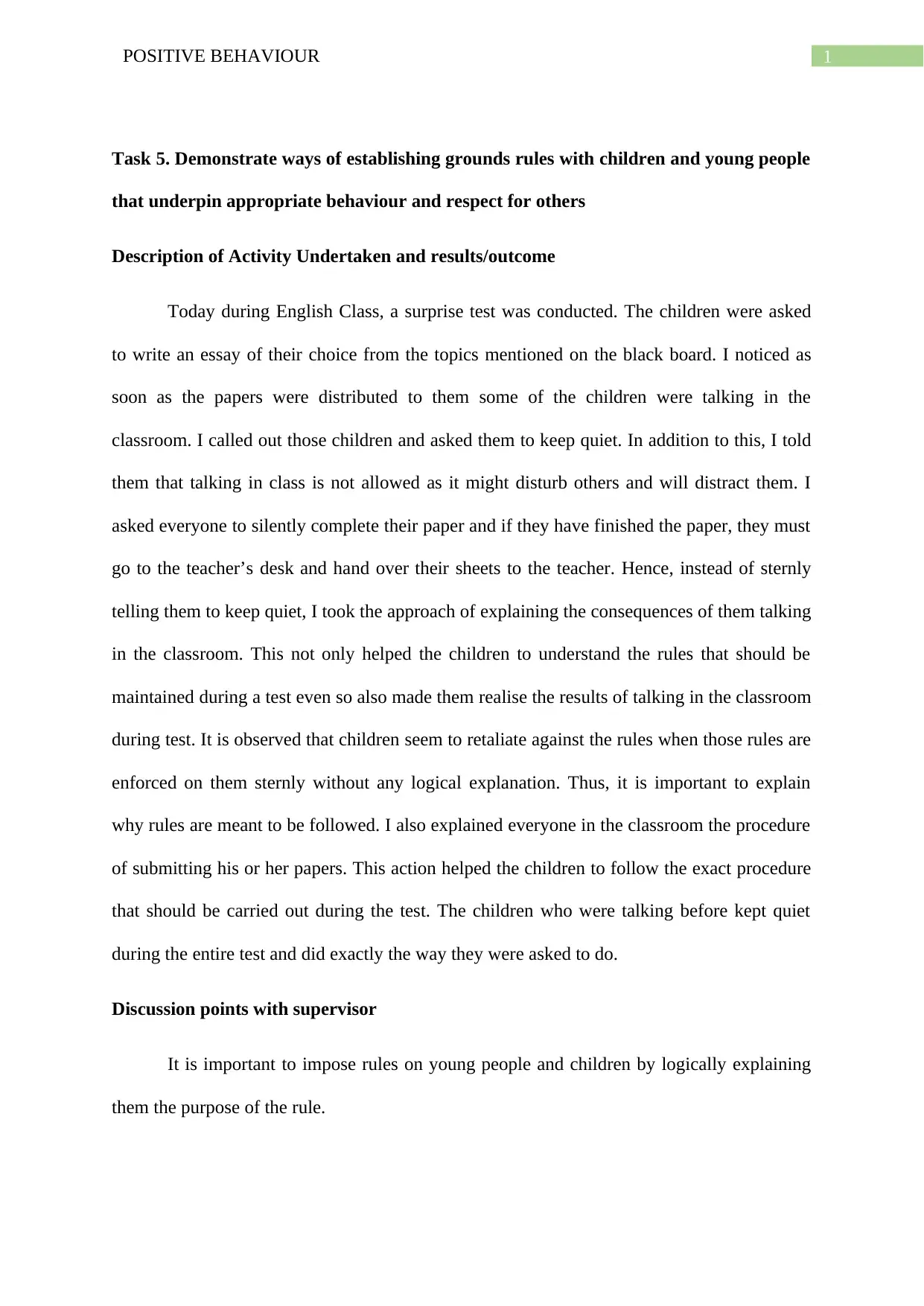
1POSITIVE BEHAVIOUR
Task 5. Demonstrate ways of establishing grounds rules with children and young people
that underpin appropriate behaviour and respect for others
Description of Activity Undertaken and results/outcome
Today during English Class, a surprise test was conducted. The children were asked
to write an essay of their choice from the topics mentioned on the black board. I noticed as
soon as the papers were distributed to them some of the children were talking in the
classroom. I called out those children and asked them to keep quiet. In addition to this, I told
them that talking in class is not allowed as it might disturb others and will distract them. I
asked everyone to silently complete their paper and if they have finished the paper, they must
go to the teacher’s desk and hand over their sheets to the teacher. Hence, instead of sternly
telling them to keep quiet, I took the approach of explaining the consequences of them talking
in the classroom. This not only helped the children to understand the rules that should be
maintained during a test even so also made them realise the results of talking in the classroom
during test. It is observed that children seem to retaliate against the rules when those rules are
enforced on them sternly without any logical explanation. Thus, it is important to explain
why rules are meant to be followed. I also explained everyone in the classroom the procedure
of submitting his or her papers. This action helped the children to follow the exact procedure
that should be carried out during the test. The children who were talking before kept quiet
during the entire test and did exactly the way they were asked to do.
Discussion points with supervisor
It is important to impose rules on young people and children by logically explaining
them the purpose of the rule.
Task 5. Demonstrate ways of establishing grounds rules with children and young people
that underpin appropriate behaviour and respect for others
Description of Activity Undertaken and results/outcome
Today during English Class, a surprise test was conducted. The children were asked
to write an essay of their choice from the topics mentioned on the black board. I noticed as
soon as the papers were distributed to them some of the children were talking in the
classroom. I called out those children and asked them to keep quiet. In addition to this, I told
them that talking in class is not allowed as it might disturb others and will distract them. I
asked everyone to silently complete their paper and if they have finished the paper, they must
go to the teacher’s desk and hand over their sheets to the teacher. Hence, instead of sternly
telling them to keep quiet, I took the approach of explaining the consequences of them talking
in the classroom. This not only helped the children to understand the rules that should be
maintained during a test even so also made them realise the results of talking in the classroom
during test. It is observed that children seem to retaliate against the rules when those rules are
enforced on them sternly without any logical explanation. Thus, it is important to explain
why rules are meant to be followed. I also explained everyone in the classroom the procedure
of submitting his or her papers. This action helped the children to follow the exact procedure
that should be carried out during the test. The children who were talking before kept quiet
during the entire test and did exactly the way they were asked to do.
Discussion points with supervisor
It is important to impose rules on young people and children by logically explaining
them the purpose of the rule.
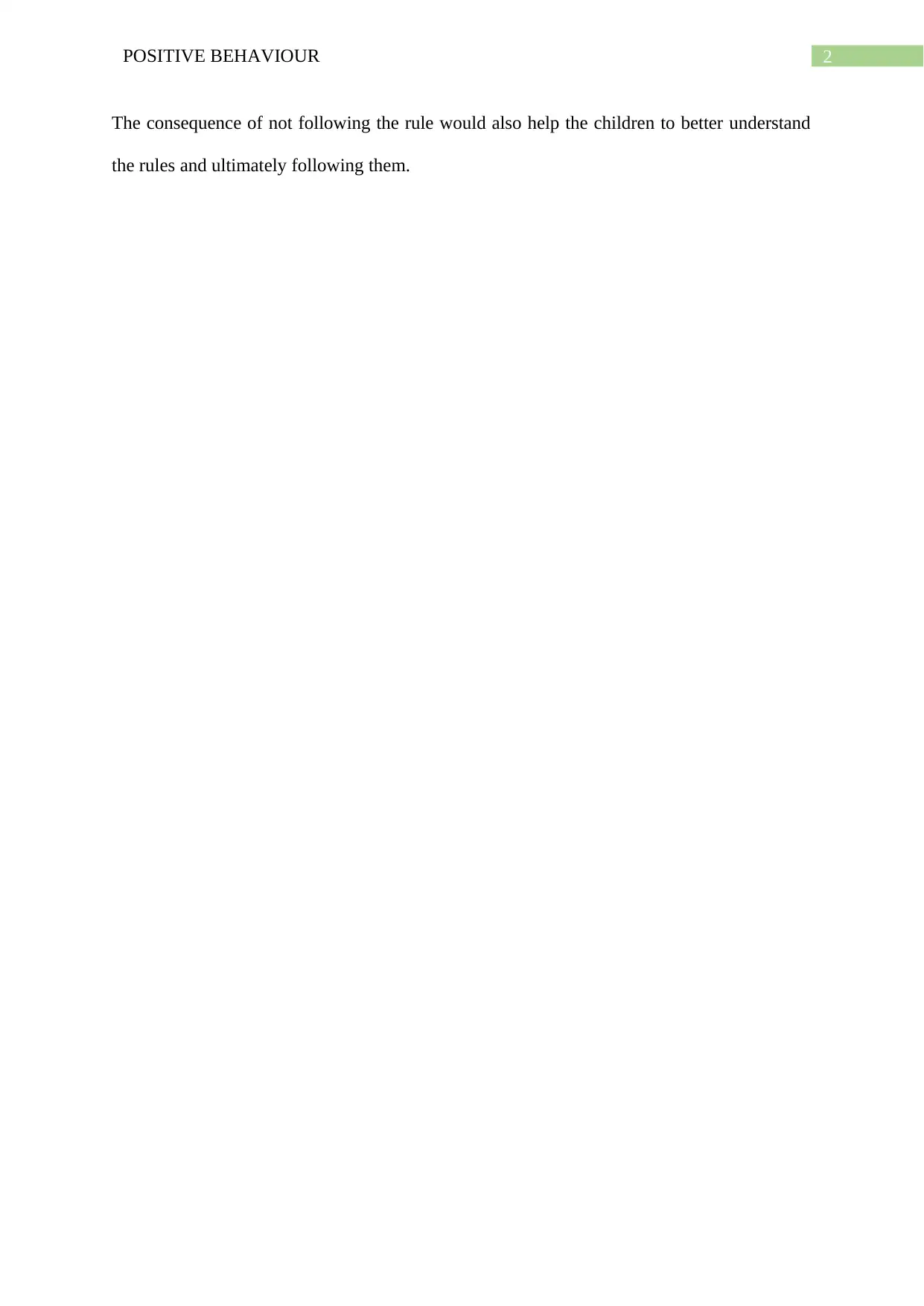
2POSITIVE BEHAVIOUR
The consequence of not following the rule would also help the children to better understand
the rules and ultimately following them.
The consequence of not following the rule would also help the children to better understand
the rules and ultimately following them.
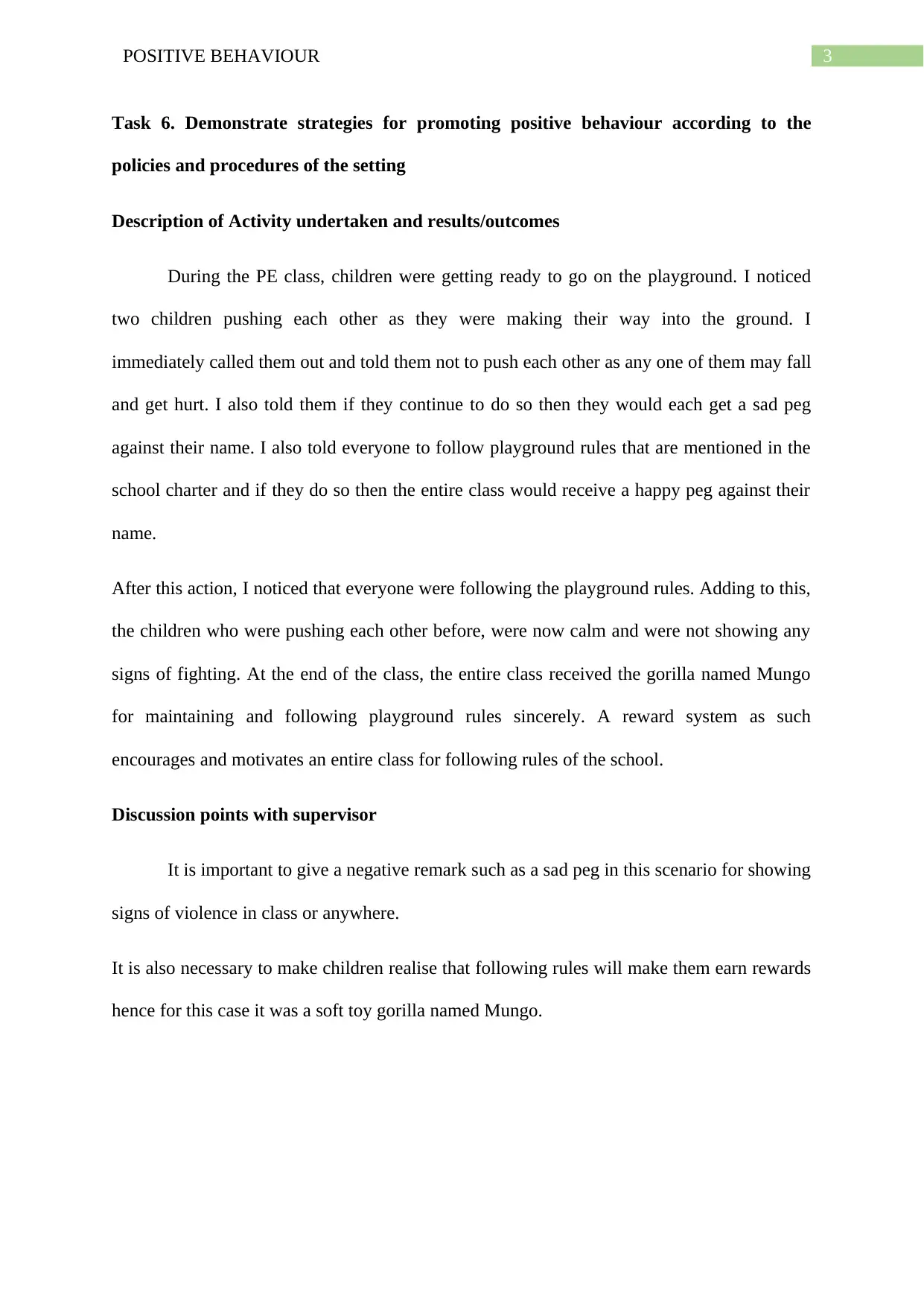
3POSITIVE BEHAVIOUR
Task 6. Demonstrate strategies for promoting positive behaviour according to the
policies and procedures of the setting
Description of Activity undertaken and results/outcomes
During the PE class, children were getting ready to go on the playground. I noticed
two children pushing each other as they were making their way into the ground. I
immediately called them out and told them not to push each other as any one of them may fall
and get hurt. I also told them if they continue to do so then they would each get a sad peg
against their name. I also told everyone to follow playground rules that are mentioned in the
school charter and if they do so then the entire class would receive a happy peg against their
name.
After this action, I noticed that everyone were following the playground rules. Adding to this,
the children who were pushing each other before, were now calm and were not showing any
signs of fighting. At the end of the class, the entire class received the gorilla named Mungo
for maintaining and following playground rules sincerely. A reward system as such
encourages and motivates an entire class for following rules of the school.
Discussion points with supervisor
It is important to give a negative remark such as a sad peg in this scenario for showing
signs of violence in class or anywhere.
It is also necessary to make children realise that following rules will make them earn rewards
hence for this case it was a soft toy gorilla named Mungo.
Task 6. Demonstrate strategies for promoting positive behaviour according to the
policies and procedures of the setting
Description of Activity undertaken and results/outcomes
During the PE class, children were getting ready to go on the playground. I noticed
two children pushing each other as they were making their way into the ground. I
immediately called them out and told them not to push each other as any one of them may fall
and get hurt. I also told them if they continue to do so then they would each get a sad peg
against their name. I also told everyone to follow playground rules that are mentioned in the
school charter and if they do so then the entire class would receive a happy peg against their
name.
After this action, I noticed that everyone were following the playground rules. Adding to this,
the children who were pushing each other before, were now calm and were not showing any
signs of fighting. At the end of the class, the entire class received the gorilla named Mungo
for maintaining and following playground rules sincerely. A reward system as such
encourages and motivates an entire class for following rules of the school.
Discussion points with supervisor
It is important to give a negative remark such as a sad peg in this scenario for showing
signs of violence in class or anywhere.
It is also necessary to make children realise that following rules will make them earn rewards
hence for this case it was a soft toy gorilla named Mungo.
Secure Best Marks with AI Grader
Need help grading? Try our AI Grader for instant feedback on your assignments.
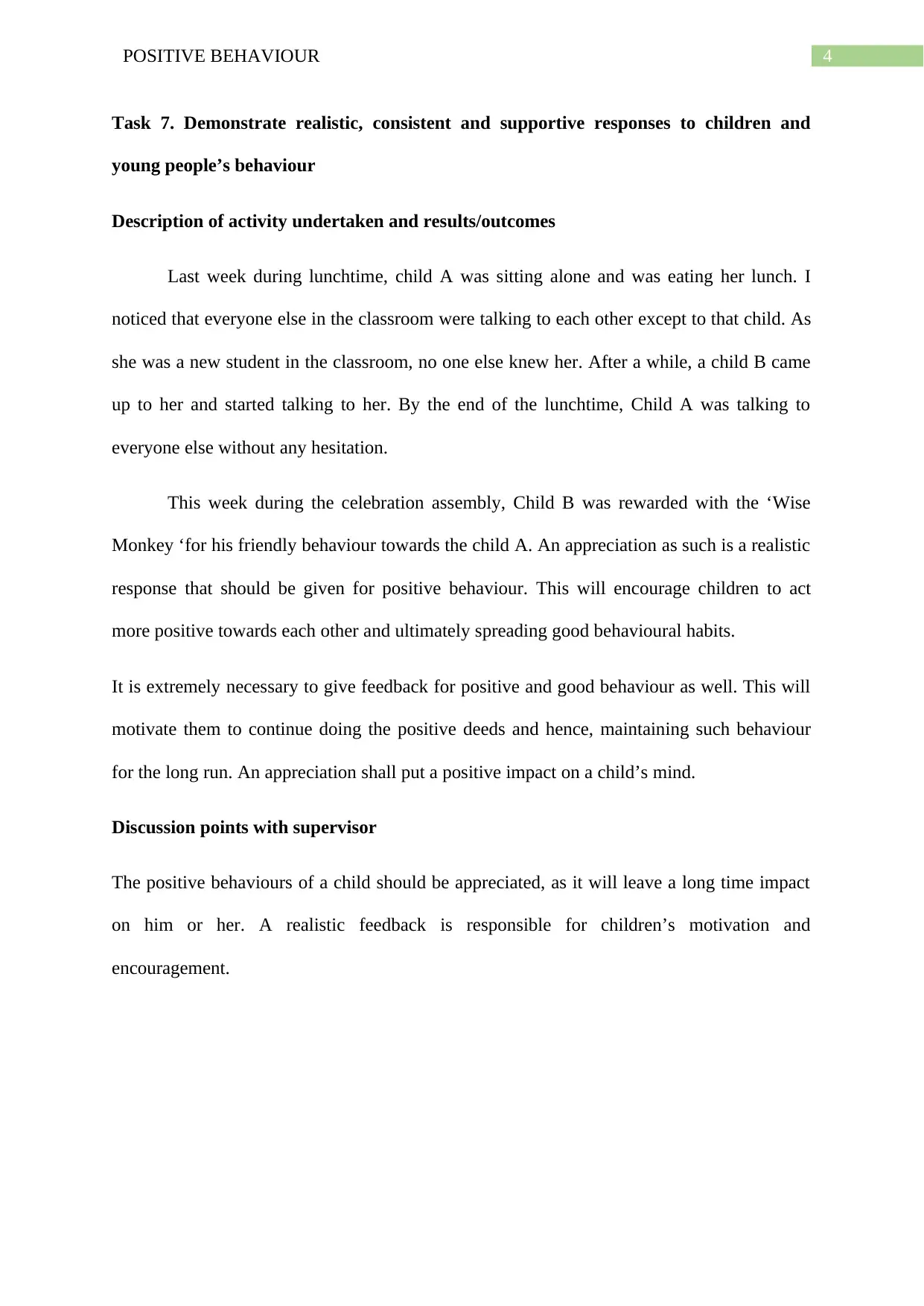
4POSITIVE BEHAVIOUR
Task 7. Demonstrate realistic, consistent and supportive responses to children and
young people’s behaviour
Description of activity undertaken and results/outcomes
Last week during lunchtime, child A was sitting alone and was eating her lunch. I
noticed that everyone else in the classroom were talking to each other except to that child. As
she was a new student in the classroom, no one else knew her. After a while, a child B came
up to her and started talking to her. By the end of the lunchtime, Child A was talking to
everyone else without any hesitation.
This week during the celebration assembly, Child B was rewarded with the ‘Wise
Monkey ‘for his friendly behaviour towards the child A. An appreciation as such is a realistic
response that should be given for positive behaviour. This will encourage children to act
more positive towards each other and ultimately spreading good behavioural habits.
It is extremely necessary to give feedback for positive and good behaviour as well. This will
motivate them to continue doing the positive deeds and hence, maintaining such behaviour
for the long run. An appreciation shall put a positive impact on a child’s mind.
Discussion points with supervisor
The positive behaviours of a child should be appreciated, as it will leave a long time impact
on him or her. A realistic feedback is responsible for children’s motivation and
encouragement.
Task 7. Demonstrate realistic, consistent and supportive responses to children and
young people’s behaviour
Description of activity undertaken and results/outcomes
Last week during lunchtime, child A was sitting alone and was eating her lunch. I
noticed that everyone else in the classroom were talking to each other except to that child. As
she was a new student in the classroom, no one else knew her. After a while, a child B came
up to her and started talking to her. By the end of the lunchtime, Child A was talking to
everyone else without any hesitation.
This week during the celebration assembly, Child B was rewarded with the ‘Wise
Monkey ‘for his friendly behaviour towards the child A. An appreciation as such is a realistic
response that should be given for positive behaviour. This will encourage children to act
more positive towards each other and ultimately spreading good behavioural habits.
It is extremely necessary to give feedback for positive and good behaviour as well. This will
motivate them to continue doing the positive deeds and hence, maintaining such behaviour
for the long run. An appreciation shall put a positive impact on a child’s mind.
Discussion points with supervisor
The positive behaviours of a child should be appreciated, as it will leave a long time impact
on him or her. A realistic feedback is responsible for children’s motivation and
encouragement.
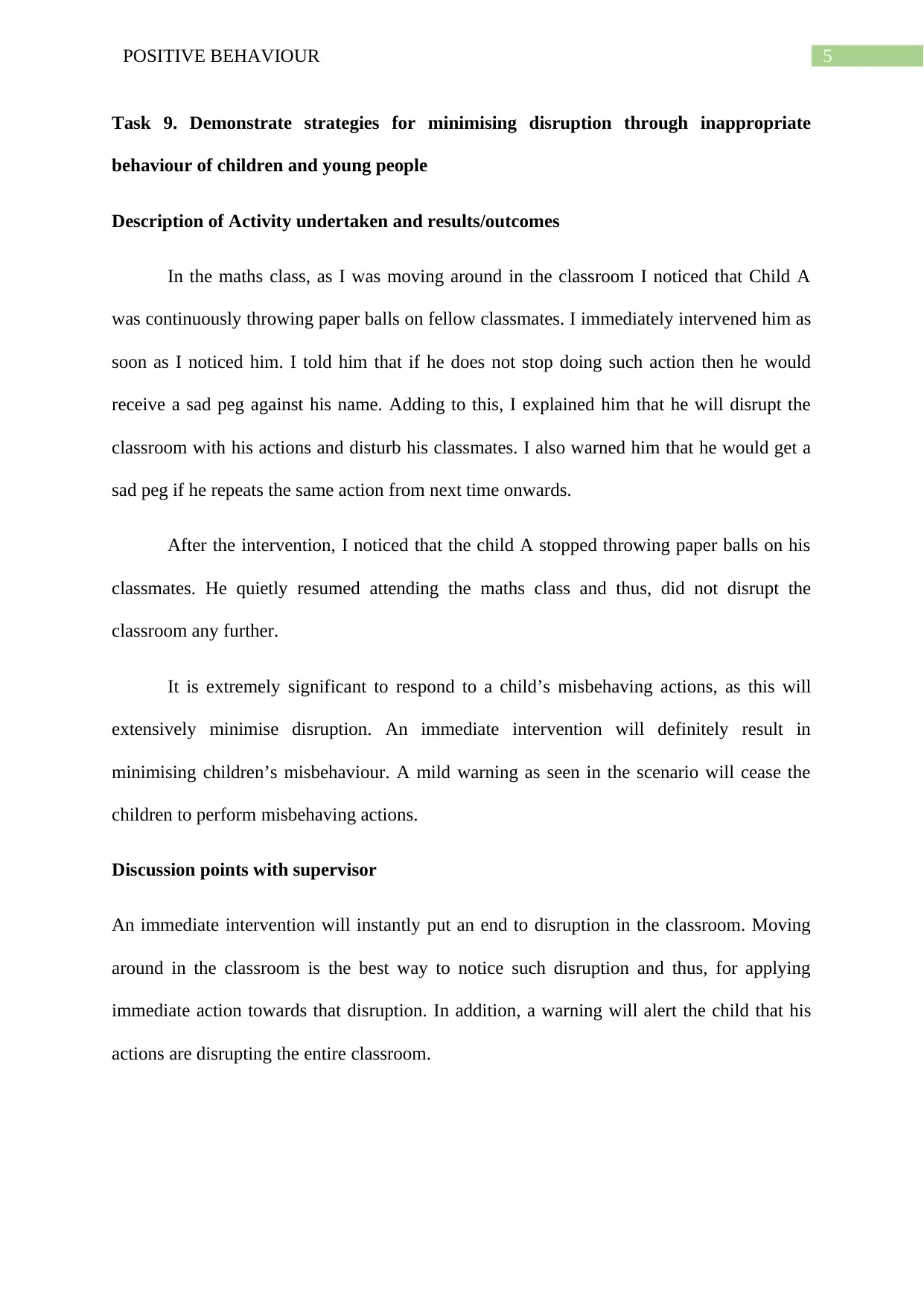
5POSITIVE BEHAVIOUR
Task 9. Demonstrate strategies for minimising disruption through inappropriate
behaviour of children and young people
Description of Activity undertaken and results/outcomes
In the maths class, as I was moving around in the classroom I noticed that Child A
was continuously throwing paper balls on fellow classmates. I immediately intervened him as
soon as I noticed him. I told him that if he does not stop doing such action then he would
receive a sad peg against his name. Adding to this, I explained him that he will disrupt the
classroom with his actions and disturb his classmates. I also warned him that he would get a
sad peg if he repeats the same action from next time onwards.
After the intervention, I noticed that the child A stopped throwing paper balls on his
classmates. He quietly resumed attending the maths class and thus, did not disrupt the
classroom any further.
It is extremely significant to respond to a child’s misbehaving actions, as this will
extensively minimise disruption. An immediate intervention will definitely result in
minimising children’s misbehaviour. A mild warning as seen in the scenario will cease the
children to perform misbehaving actions.
Discussion points with supervisor
An immediate intervention will instantly put an end to disruption in the classroom. Moving
around in the classroom is the best way to notice such disruption and thus, for applying
immediate action towards that disruption. In addition, a warning will alert the child that his
actions are disrupting the entire classroom.
Task 9. Demonstrate strategies for minimising disruption through inappropriate
behaviour of children and young people
Description of Activity undertaken and results/outcomes
In the maths class, as I was moving around in the classroom I noticed that Child A
was continuously throwing paper balls on fellow classmates. I immediately intervened him as
soon as I noticed him. I told him that if he does not stop doing such action then he would
receive a sad peg against his name. Adding to this, I explained him that he will disrupt the
classroom with his actions and disturb his classmates. I also warned him that he would get a
sad peg if he repeats the same action from next time onwards.
After the intervention, I noticed that the child A stopped throwing paper balls on his
classmates. He quietly resumed attending the maths class and thus, did not disrupt the
classroom any further.
It is extremely significant to respond to a child’s misbehaving actions, as this will
extensively minimise disruption. An immediate intervention will definitely result in
minimising children’s misbehaviour. A mild warning as seen in the scenario will cease the
children to perform misbehaving actions.
Discussion points with supervisor
An immediate intervention will instantly put an end to disruption in the classroom. Moving
around in the classroom is the best way to notice such disruption and thus, for applying
immediate action towards that disruption. In addition, a warning will alert the child that his
actions are disrupting the entire classroom.
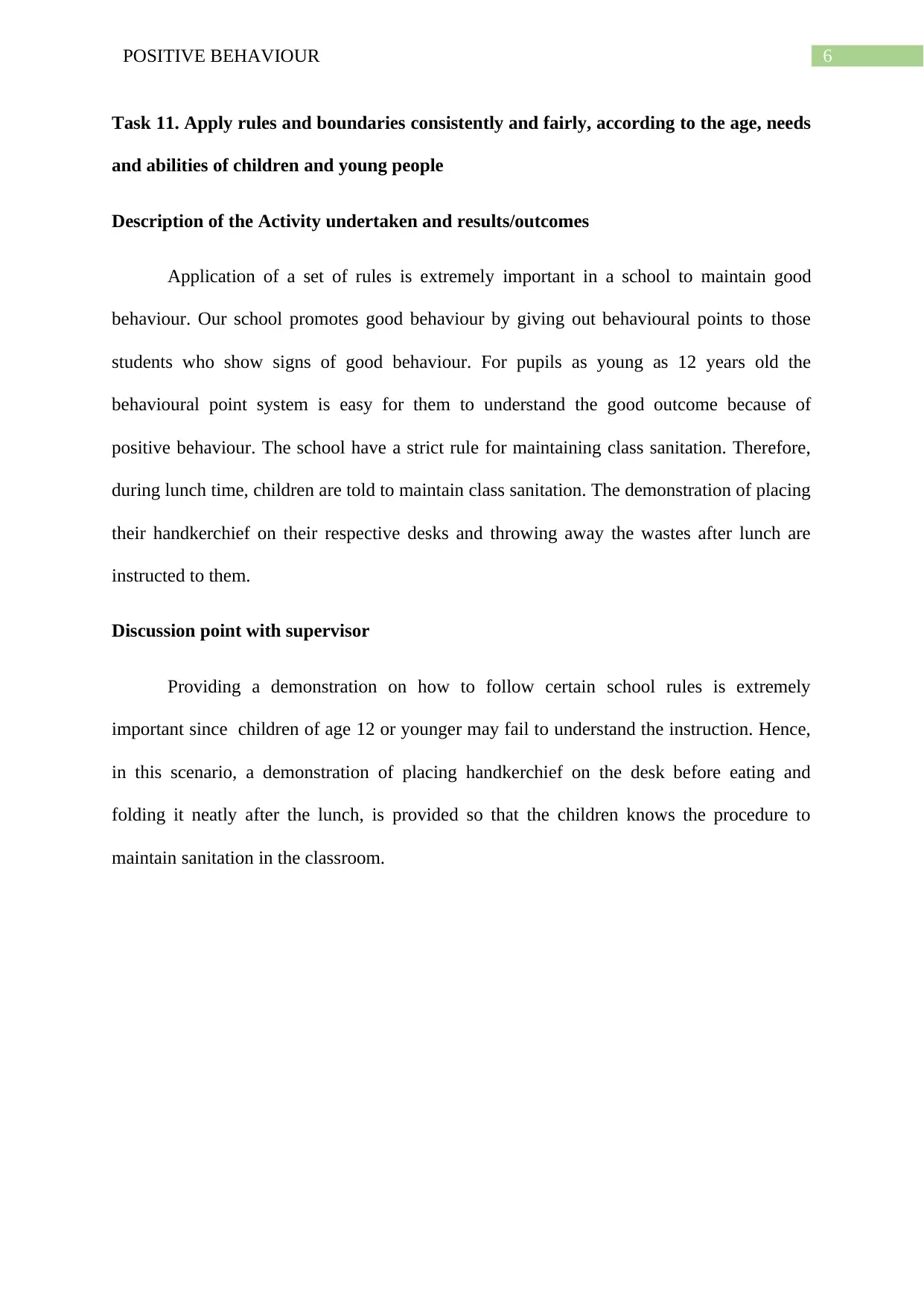
6POSITIVE BEHAVIOUR
Task 11. Apply rules and boundaries consistently and fairly, according to the age, needs
and abilities of children and young people
Description of the Activity undertaken and results/outcomes
Application of a set of rules is extremely important in a school to maintain good
behaviour. Our school promotes good behaviour by giving out behavioural points to those
students who show signs of good behaviour. For pupils as young as 12 years old the
behavioural point system is easy for them to understand the good outcome because of
positive behaviour. The school have a strict rule for maintaining class sanitation. Therefore,
during lunch time, children are told to maintain class sanitation. The demonstration of placing
their handkerchief on their respective desks and throwing away the wastes after lunch are
instructed to them.
Discussion point with supervisor
Providing a demonstration on how to follow certain school rules is extremely
important since children of age 12 or younger may fail to understand the instruction. Hence,
in this scenario, a demonstration of placing handkerchief on the desk before eating and
folding it neatly after the lunch, is provided so that the children knows the procedure to
maintain sanitation in the classroom.
Task 11. Apply rules and boundaries consistently and fairly, according to the age, needs
and abilities of children and young people
Description of the Activity undertaken and results/outcomes
Application of a set of rules is extremely important in a school to maintain good
behaviour. Our school promotes good behaviour by giving out behavioural points to those
students who show signs of good behaviour. For pupils as young as 12 years old the
behavioural point system is easy for them to understand the good outcome because of
positive behaviour. The school have a strict rule for maintaining class sanitation. Therefore,
during lunch time, children are told to maintain class sanitation. The demonstration of placing
their handkerchief on their respective desks and throwing away the wastes after lunch are
instructed to them.
Discussion point with supervisor
Providing a demonstration on how to follow certain school rules is extremely
important since children of age 12 or younger may fail to understand the instruction. Hence,
in this scenario, a demonstration of placing handkerchief on the desk before eating and
folding it neatly after the lunch, is provided so that the children knows the procedure to
maintain sanitation in the classroom.
Paraphrase This Document
Need a fresh take? Get an instant paraphrase of this document with our AI Paraphraser
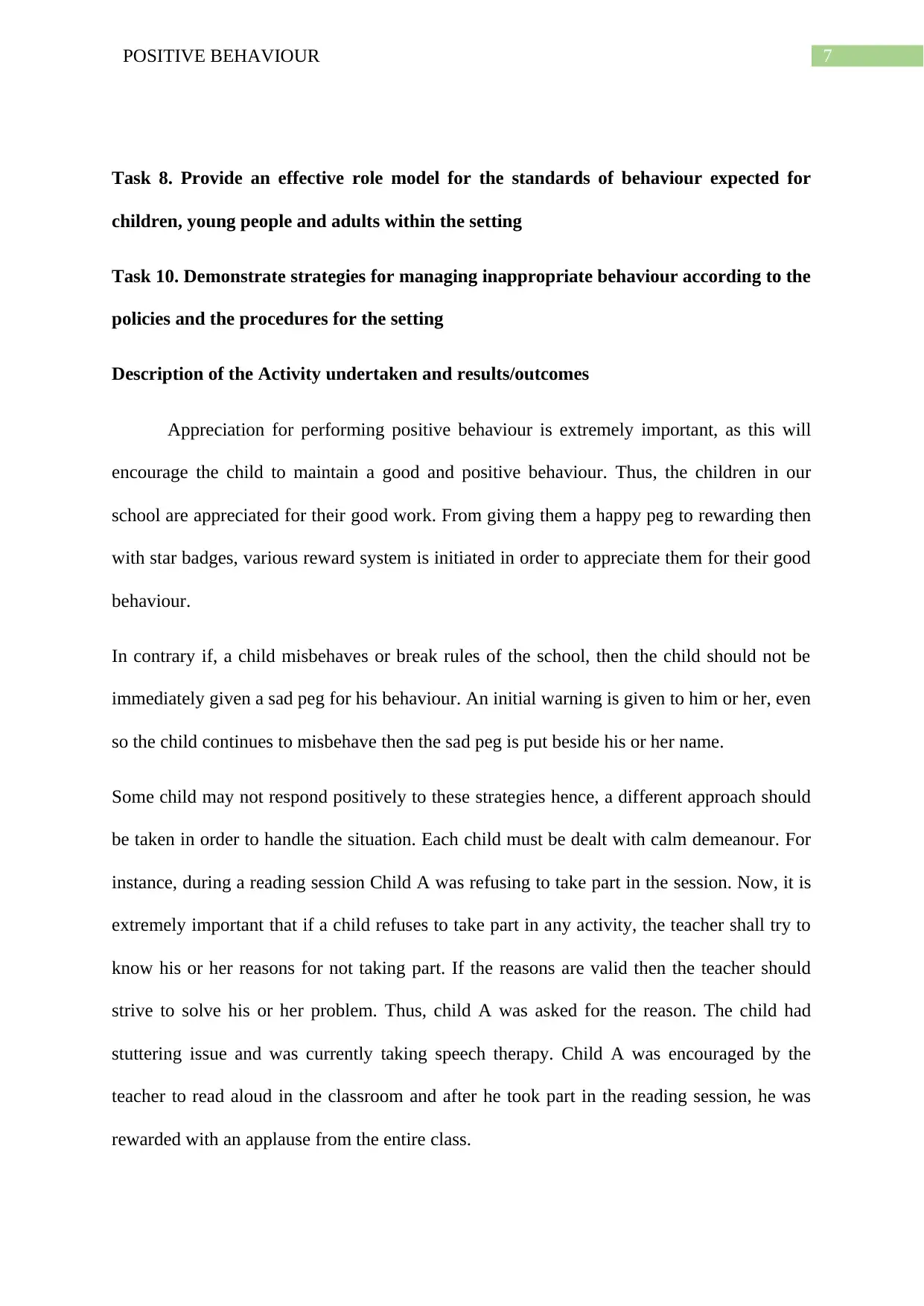
7POSITIVE BEHAVIOUR
Task 8. Provide an effective role model for the standards of behaviour expected for
children, young people and adults within the setting
Task 10. Demonstrate strategies for managing inappropriate behaviour according to the
policies and the procedures for the setting
Description of the Activity undertaken and results/outcomes
Appreciation for performing positive behaviour is extremely important, as this will
encourage the child to maintain a good and positive behaviour. Thus, the children in our
school are appreciated for their good work. From giving them a happy peg to rewarding then
with star badges, various reward system is initiated in order to appreciate them for their good
behaviour.
In contrary if, a child misbehaves or break rules of the school, then the child should not be
immediately given a sad peg for his behaviour. An initial warning is given to him or her, even
so the child continues to misbehave then the sad peg is put beside his or her name.
Some child may not respond positively to these strategies hence, a different approach should
be taken in order to handle the situation. Each child must be dealt with calm demeanour. For
instance, during a reading session Child A was refusing to take part in the session. Now, it is
extremely important that if a child refuses to take part in any activity, the teacher shall try to
know his or her reasons for not taking part. If the reasons are valid then the teacher should
strive to solve his or her problem. Thus, child A was asked for the reason. The child had
stuttering issue and was currently taking speech therapy. Child A was encouraged by the
teacher to read aloud in the classroom and after he took part in the reading session, he was
rewarded with an applause from the entire class.
Task 8. Provide an effective role model for the standards of behaviour expected for
children, young people and adults within the setting
Task 10. Demonstrate strategies for managing inappropriate behaviour according to the
policies and the procedures for the setting
Description of the Activity undertaken and results/outcomes
Appreciation for performing positive behaviour is extremely important, as this will
encourage the child to maintain a good and positive behaviour. Thus, the children in our
school are appreciated for their good work. From giving them a happy peg to rewarding then
with star badges, various reward system is initiated in order to appreciate them for their good
behaviour.
In contrary if, a child misbehaves or break rules of the school, then the child should not be
immediately given a sad peg for his behaviour. An initial warning is given to him or her, even
so the child continues to misbehave then the sad peg is put beside his or her name.
Some child may not respond positively to these strategies hence, a different approach should
be taken in order to handle the situation. Each child must be dealt with calm demeanour. For
instance, during a reading session Child A was refusing to take part in the session. Now, it is
extremely important that if a child refuses to take part in any activity, the teacher shall try to
know his or her reasons for not taking part. If the reasons are valid then the teacher should
strive to solve his or her problem. Thus, child A was asked for the reason. The child had
stuttering issue and was currently taking speech therapy. Child A was encouraged by the
teacher to read aloud in the classroom and after he took part in the reading session, he was
rewarded with an applause from the entire class.
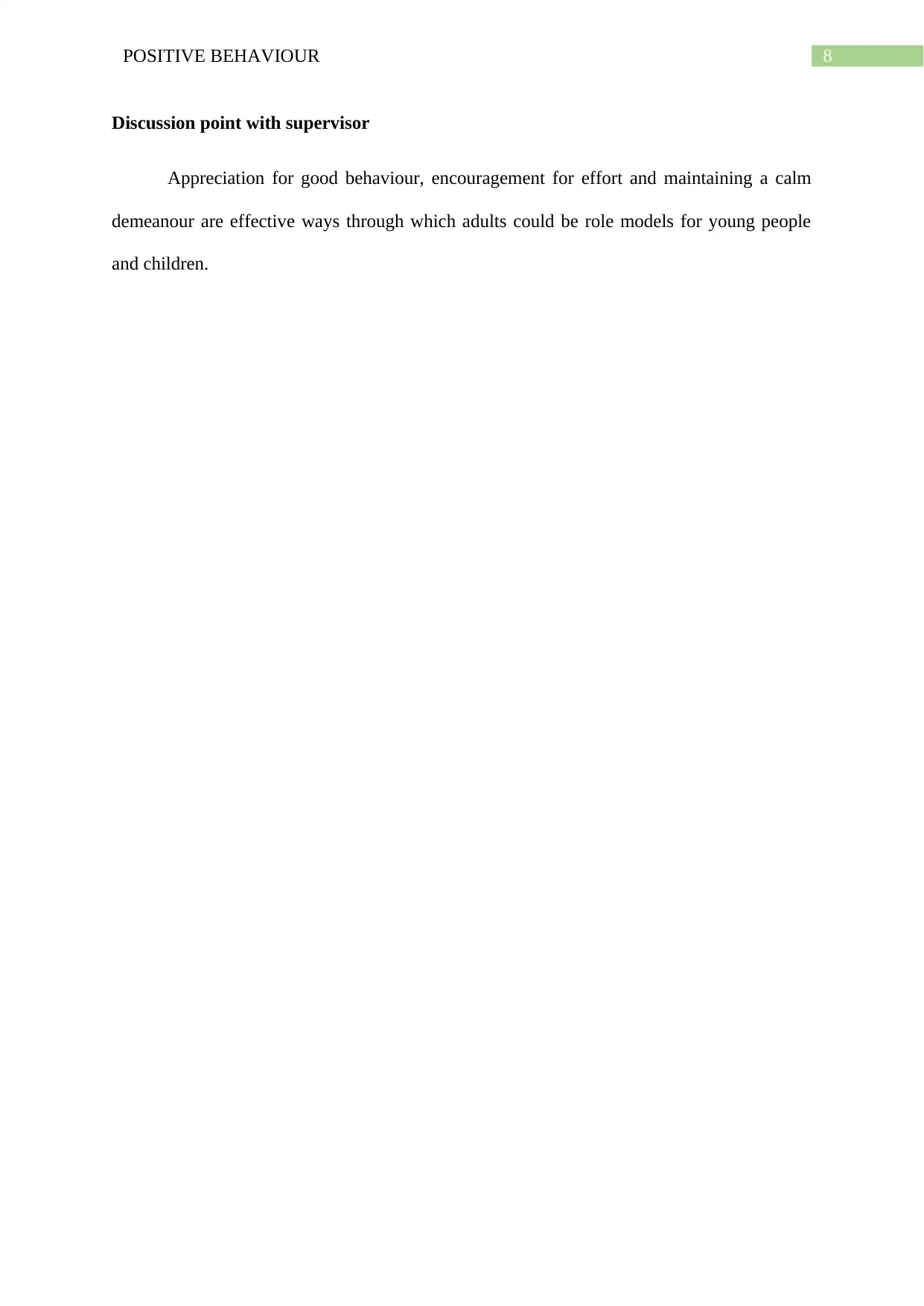
8POSITIVE BEHAVIOUR
Discussion point with supervisor
Appreciation for good behaviour, encouragement for effort and maintaining a calm
demeanour are effective ways through which adults could be role models for young people
and children.
Discussion point with supervisor
Appreciation for good behaviour, encouragement for effort and maintaining a calm
demeanour are effective ways through which adults could be role models for young people
and children.
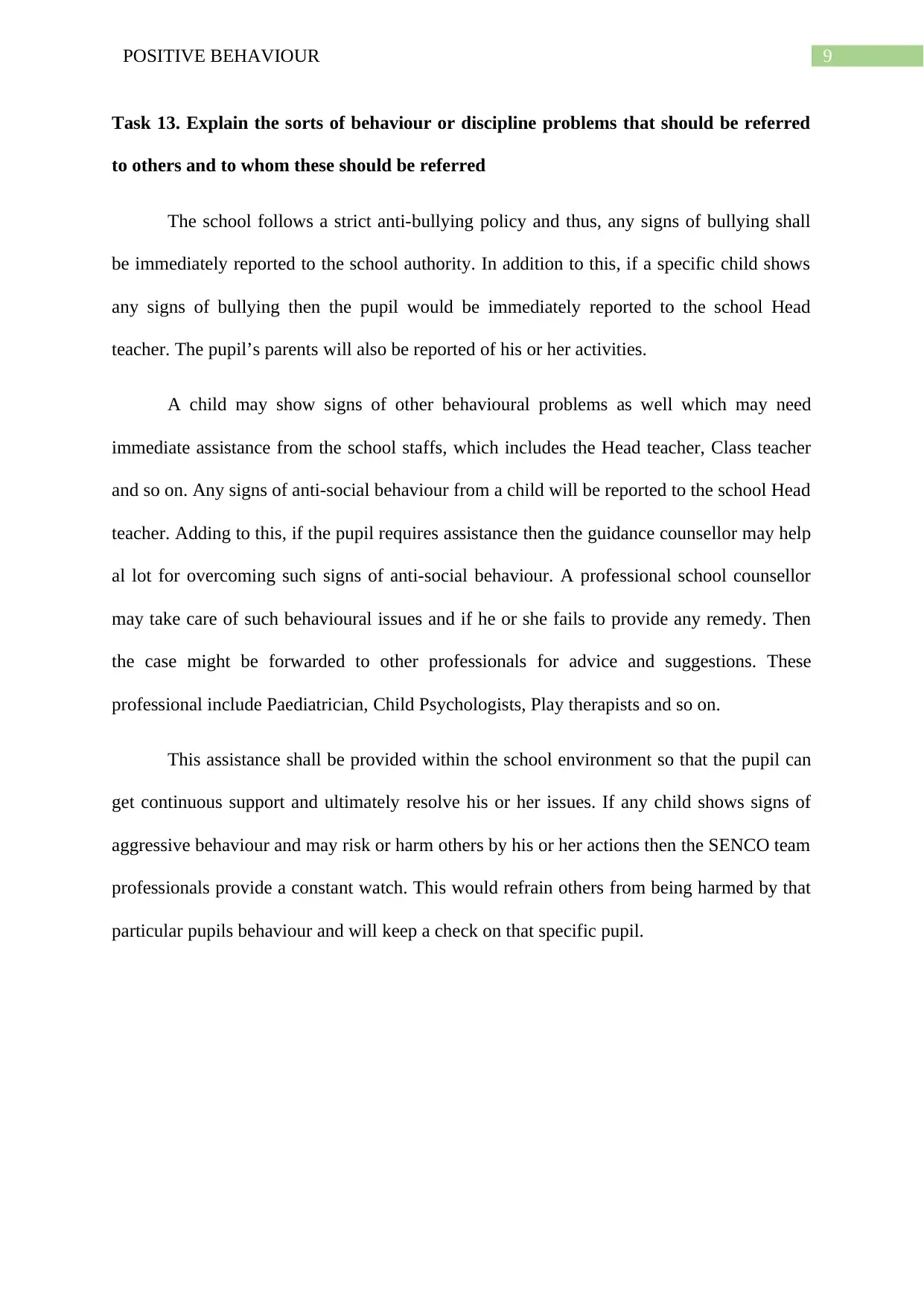
9POSITIVE BEHAVIOUR
Task 13. Explain the sorts of behaviour or discipline problems that should be referred
to others and to whom these should be referred
The school follows a strict anti-bullying policy and thus, any signs of bullying shall
be immediately reported to the school authority. In addition to this, if a specific child shows
any signs of bullying then the pupil would be immediately reported to the school Head
teacher. The pupil’s parents will also be reported of his or her activities.
A child may show signs of other behavioural problems as well which may need
immediate assistance from the school staffs, which includes the Head teacher, Class teacher
and so on. Any signs of anti-social behaviour from a child will be reported to the school Head
teacher. Adding to this, if the pupil requires assistance then the guidance counsellor may help
al lot for overcoming such signs of anti-social behaviour. A professional school counsellor
may take care of such behavioural issues and if he or she fails to provide any remedy. Then
the case might be forwarded to other professionals for advice and suggestions. These
professional include Paediatrician, Child Psychologists, Play therapists and so on.
This assistance shall be provided within the school environment so that the pupil can
get continuous support and ultimately resolve his or her issues. If any child shows signs of
aggressive behaviour and may risk or harm others by his or her actions then the SENCO team
professionals provide a constant watch. This would refrain others from being harmed by that
particular pupils behaviour and will keep a check on that specific pupil.
Task 13. Explain the sorts of behaviour or discipline problems that should be referred
to others and to whom these should be referred
The school follows a strict anti-bullying policy and thus, any signs of bullying shall
be immediately reported to the school authority. In addition to this, if a specific child shows
any signs of bullying then the pupil would be immediately reported to the school Head
teacher. The pupil’s parents will also be reported of his or her activities.
A child may show signs of other behavioural problems as well which may need
immediate assistance from the school staffs, which includes the Head teacher, Class teacher
and so on. Any signs of anti-social behaviour from a child will be reported to the school Head
teacher. Adding to this, if the pupil requires assistance then the guidance counsellor may help
al lot for overcoming such signs of anti-social behaviour. A professional school counsellor
may take care of such behavioural issues and if he or she fails to provide any remedy. Then
the case might be forwarded to other professionals for advice and suggestions. These
professional include Paediatrician, Child Psychologists, Play therapists and so on.
This assistance shall be provided within the school environment so that the pupil can
get continuous support and ultimately resolve his or her issues. If any child shows signs of
aggressive behaviour and may risk or harm others by his or her actions then the SENCO team
professionals provide a constant watch. This would refrain others from being harmed by that
particular pupils behaviour and will keep a check on that specific pupil.
Secure Best Marks with AI Grader
Need help grading? Try our AI Grader for instant feedback on your assignments.
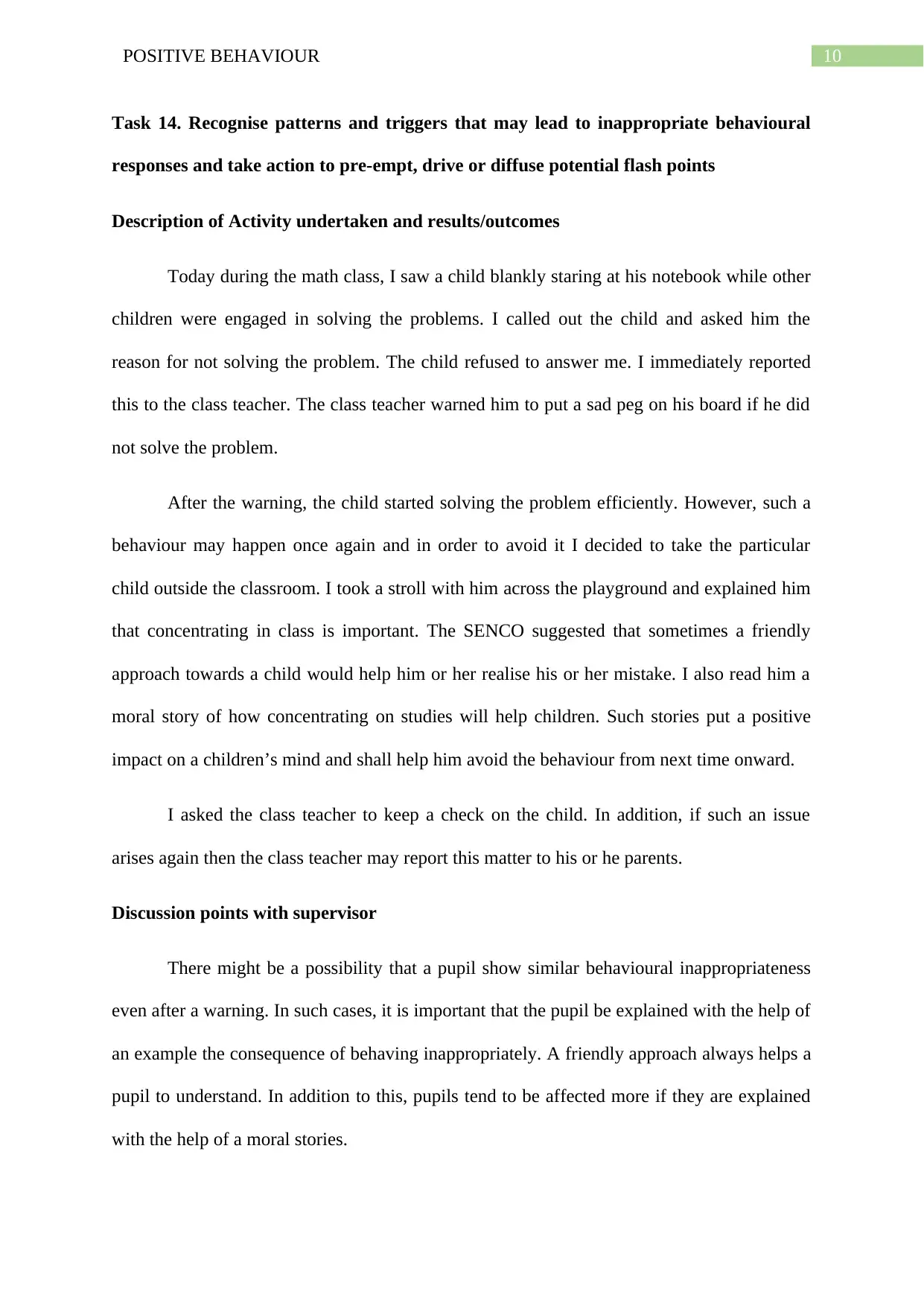
10POSITIVE BEHAVIOUR
Task 14. Recognise patterns and triggers that may lead to inappropriate behavioural
responses and take action to pre-empt, drive or diffuse potential flash points
Description of Activity undertaken and results/outcomes
Today during the math class, I saw a child blankly staring at his notebook while other
children were engaged in solving the problems. I called out the child and asked him the
reason for not solving the problem. The child refused to answer me. I immediately reported
this to the class teacher. The class teacher warned him to put a sad peg on his board if he did
not solve the problem.
After the warning, the child started solving the problem efficiently. However, such a
behaviour may happen once again and in order to avoid it I decided to take the particular
child outside the classroom. I took a stroll with him across the playground and explained him
that concentrating in class is important. The SENCO suggested that sometimes a friendly
approach towards a child would help him or her realise his or her mistake. I also read him a
moral story of how concentrating on studies will help children. Such stories put a positive
impact on a children’s mind and shall help him avoid the behaviour from next time onward.
I asked the class teacher to keep a check on the child. In addition, if such an issue
arises again then the class teacher may report this matter to his or he parents.
Discussion points with supervisor
There might be a possibility that a pupil show similar behavioural inappropriateness
even after a warning. In such cases, it is important that the pupil be explained with the help of
an example the consequence of behaving inappropriately. A friendly approach always helps a
pupil to understand. In addition to this, pupils tend to be affected more if they are explained
with the help of a moral stories.
Task 14. Recognise patterns and triggers that may lead to inappropriate behavioural
responses and take action to pre-empt, drive or diffuse potential flash points
Description of Activity undertaken and results/outcomes
Today during the math class, I saw a child blankly staring at his notebook while other
children were engaged in solving the problems. I called out the child and asked him the
reason for not solving the problem. The child refused to answer me. I immediately reported
this to the class teacher. The class teacher warned him to put a sad peg on his board if he did
not solve the problem.
After the warning, the child started solving the problem efficiently. However, such a
behaviour may happen once again and in order to avoid it I decided to take the particular
child outside the classroom. I took a stroll with him across the playground and explained him
that concentrating in class is important. The SENCO suggested that sometimes a friendly
approach towards a child would help him or her realise his or her mistake. I also read him a
moral story of how concentrating on studies will help children. Such stories put a positive
impact on a children’s mind and shall help him avoid the behaviour from next time onward.
I asked the class teacher to keep a check on the child. In addition, if such an issue
arises again then the class teacher may report this matter to his or he parents.
Discussion points with supervisor
There might be a possibility that a pupil show similar behavioural inappropriateness
even after a warning. In such cases, it is important that the pupil be explained with the help of
an example the consequence of behaving inappropriately. A friendly approach always helps a
pupil to understand. In addition to this, pupils tend to be affected more if they are explained
with the help of a moral stories.
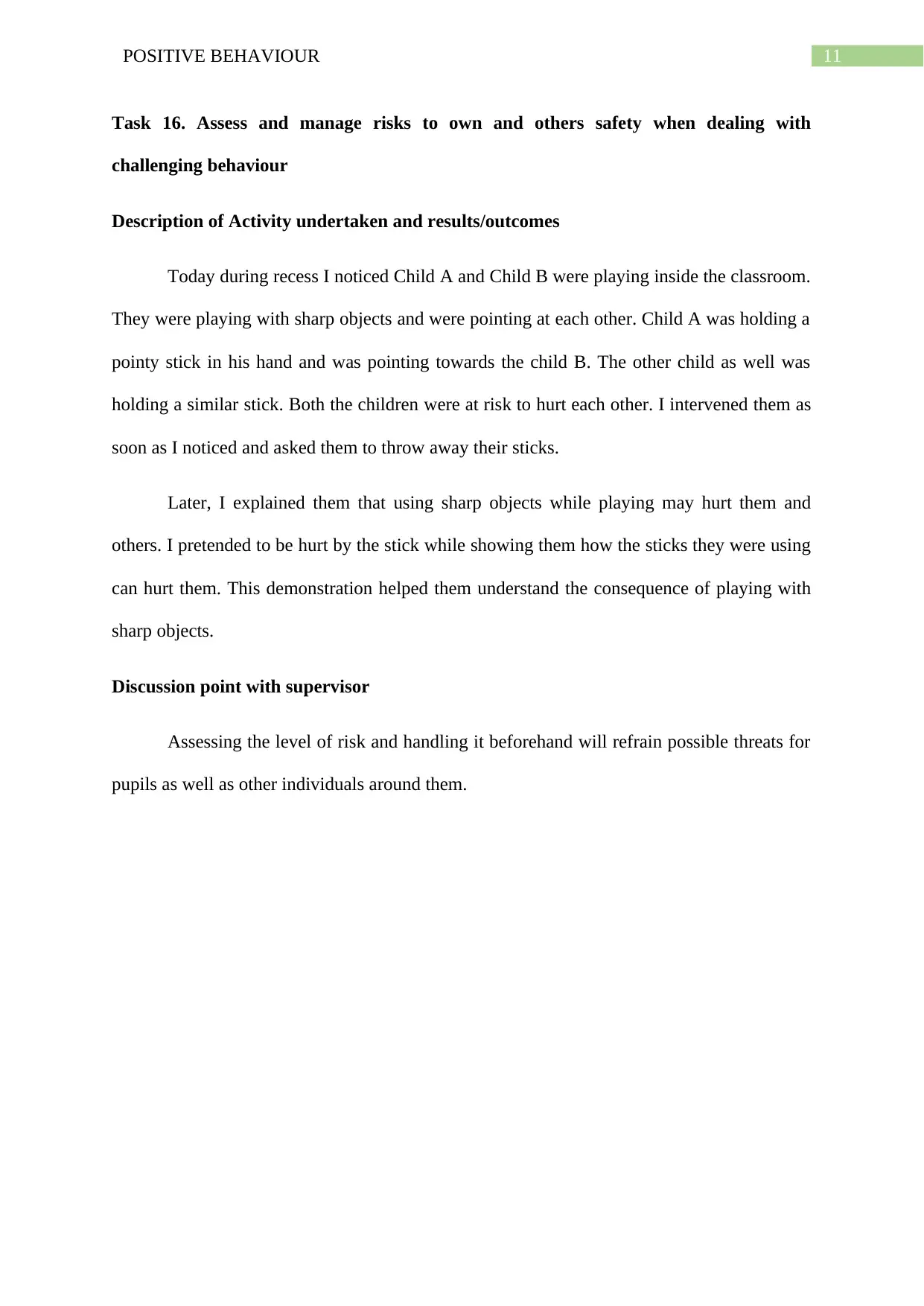
11POSITIVE BEHAVIOUR
Task 16. Assess and manage risks to own and others safety when dealing with
challenging behaviour
Description of Activity undertaken and results/outcomes
Today during recess I noticed Child A and Child B were playing inside the classroom.
They were playing with sharp objects and were pointing at each other. Child A was holding a
pointy stick in his hand and was pointing towards the child B. The other child as well was
holding a similar stick. Both the children were at risk to hurt each other. I intervened them as
soon as I noticed and asked them to throw away their sticks.
Later, I explained them that using sharp objects while playing may hurt them and
others. I pretended to be hurt by the stick while showing them how the sticks they were using
can hurt them. This demonstration helped them understand the consequence of playing with
sharp objects.
Discussion point with supervisor
Assessing the level of risk and handling it beforehand will refrain possible threats for
pupils as well as other individuals around them.
Task 16. Assess and manage risks to own and others safety when dealing with
challenging behaviour
Description of Activity undertaken and results/outcomes
Today during recess I noticed Child A and Child B were playing inside the classroom.
They were playing with sharp objects and were pointing at each other. Child A was holding a
pointy stick in his hand and was pointing towards the child B. The other child as well was
holding a similar stick. Both the children were at risk to hurt each other. I intervened them as
soon as I noticed and asked them to throw away their sticks.
Later, I explained them that using sharp objects while playing may hurt them and
others. I pretended to be hurt by the stick while showing them how the sticks they were using
can hurt them. This demonstration helped them understand the consequence of playing with
sharp objects.
Discussion point with supervisor
Assessing the level of risk and handling it beforehand will refrain possible threats for
pupils as well as other individuals around them.
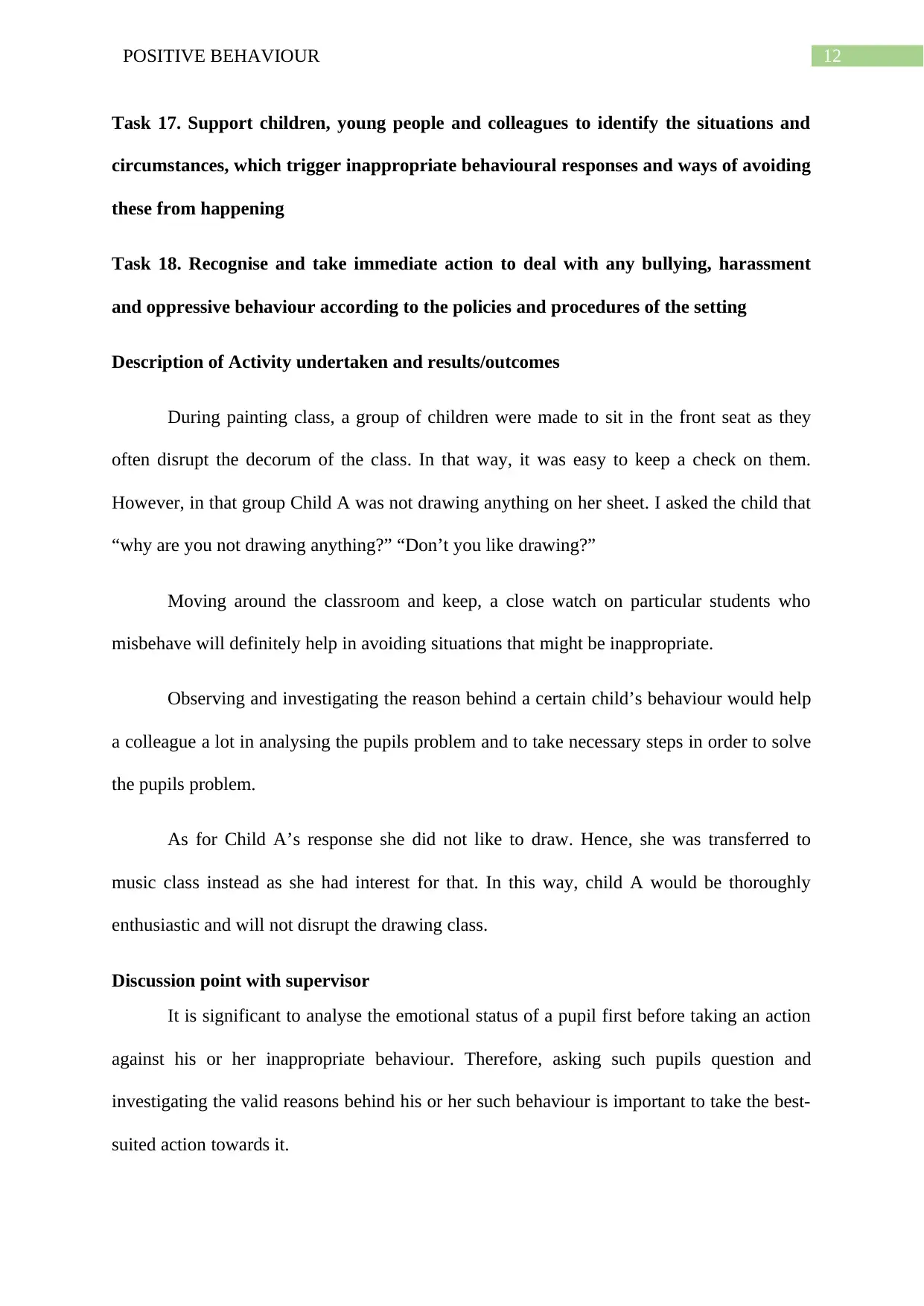
12POSITIVE BEHAVIOUR
Task 17. Support children, young people and colleagues to identify the situations and
circumstances, which trigger inappropriate behavioural responses and ways of avoiding
these from happening
Task 18. Recognise and take immediate action to deal with any bullying, harassment
and oppressive behaviour according to the policies and procedures of the setting
Description of Activity undertaken and results/outcomes
During painting class, a group of children were made to sit in the front seat as they
often disrupt the decorum of the class. In that way, it was easy to keep a check on them.
However, in that group Child A was not drawing anything on her sheet. I asked the child that
“why are you not drawing anything?” “Don’t you like drawing?”
Moving around the classroom and keep, a close watch on particular students who
misbehave will definitely help in avoiding situations that might be inappropriate.
Observing and investigating the reason behind a certain child’s behaviour would help
a colleague a lot in analysing the pupils problem and to take necessary steps in order to solve
the pupils problem.
As for Child A’s response she did not like to draw. Hence, she was transferred to
music class instead as she had interest for that. In this way, child A would be thoroughly
enthusiastic and will not disrupt the drawing class.
Discussion point with supervisor
It is significant to analyse the emotional status of a pupil first before taking an action
against his or her inappropriate behaviour. Therefore, asking such pupils question and
investigating the valid reasons behind his or her such behaviour is important to take the best-
suited action towards it.
Task 17. Support children, young people and colleagues to identify the situations and
circumstances, which trigger inappropriate behavioural responses and ways of avoiding
these from happening
Task 18. Recognise and take immediate action to deal with any bullying, harassment
and oppressive behaviour according to the policies and procedures of the setting
Description of Activity undertaken and results/outcomes
During painting class, a group of children were made to sit in the front seat as they
often disrupt the decorum of the class. In that way, it was easy to keep a check on them.
However, in that group Child A was not drawing anything on her sheet. I asked the child that
“why are you not drawing anything?” “Don’t you like drawing?”
Moving around the classroom and keep, a close watch on particular students who
misbehave will definitely help in avoiding situations that might be inappropriate.
Observing and investigating the reason behind a certain child’s behaviour would help
a colleague a lot in analysing the pupils problem and to take necessary steps in order to solve
the pupils problem.
As for Child A’s response she did not like to draw. Hence, she was transferred to
music class instead as she had interest for that. In this way, child A would be thoroughly
enthusiastic and will not disrupt the drawing class.
Discussion point with supervisor
It is significant to analyse the emotional status of a pupil first before taking an action
against his or her inappropriate behaviour. Therefore, asking such pupils question and
investigating the valid reasons behind his or her such behaviour is important to take the best-
suited action towards it.
Paraphrase This Document
Need a fresh take? Get an instant paraphrase of this document with our AI Paraphraser
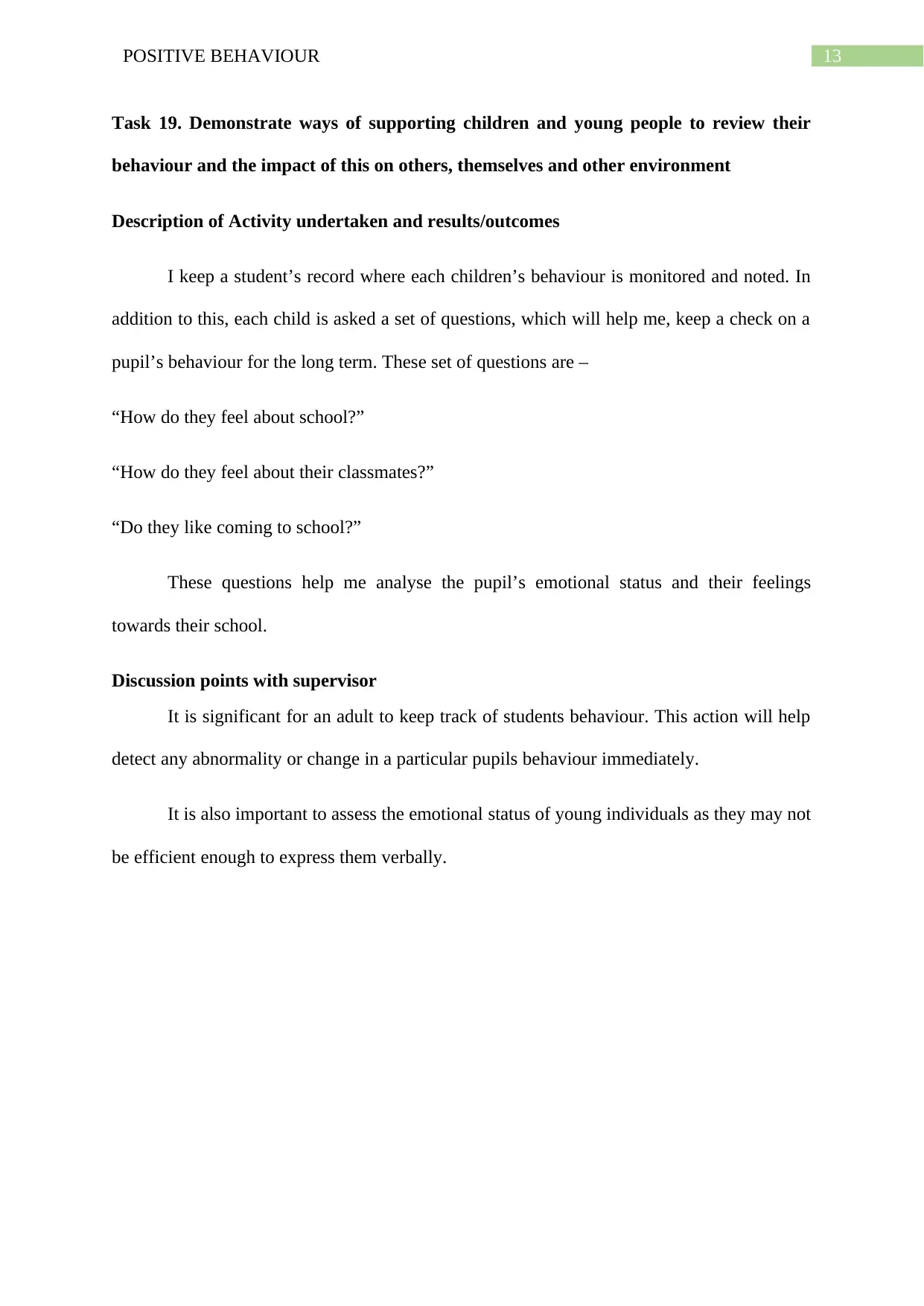
13POSITIVE BEHAVIOUR
Task 19. Demonstrate ways of supporting children and young people to review their
behaviour and the impact of this on others, themselves and other environment
Description of Activity undertaken and results/outcomes
I keep a student’s record where each children’s behaviour is monitored and noted. In
addition to this, each child is asked a set of questions, which will help me, keep a check on a
pupil’s behaviour for the long term. These set of questions are –
“How do they feel about school?”
“How do they feel about their classmates?”
“Do they like coming to school?”
These questions help me analyse the pupil’s emotional status and their feelings
towards their school.
Discussion points with supervisor
It is significant for an adult to keep track of students behaviour. This action will help
detect any abnormality or change in a particular pupils behaviour immediately.
It is also important to assess the emotional status of young individuals as they may not
be efficient enough to express them verbally.
Task 19. Demonstrate ways of supporting children and young people to review their
behaviour and the impact of this on others, themselves and other environment
Description of Activity undertaken and results/outcomes
I keep a student’s record where each children’s behaviour is monitored and noted. In
addition to this, each child is asked a set of questions, which will help me, keep a check on a
pupil’s behaviour for the long term. These set of questions are –
“How do they feel about school?”
“How do they feel about their classmates?”
“Do they like coming to school?”
These questions help me analyse the pupil’s emotional status and their feelings
towards their school.
Discussion points with supervisor
It is significant for an adult to keep track of students behaviour. This action will help
detect any abnormality or change in a particular pupils behaviour immediately.
It is also important to assess the emotional status of young individuals as they may not
be efficient enough to express them verbally.
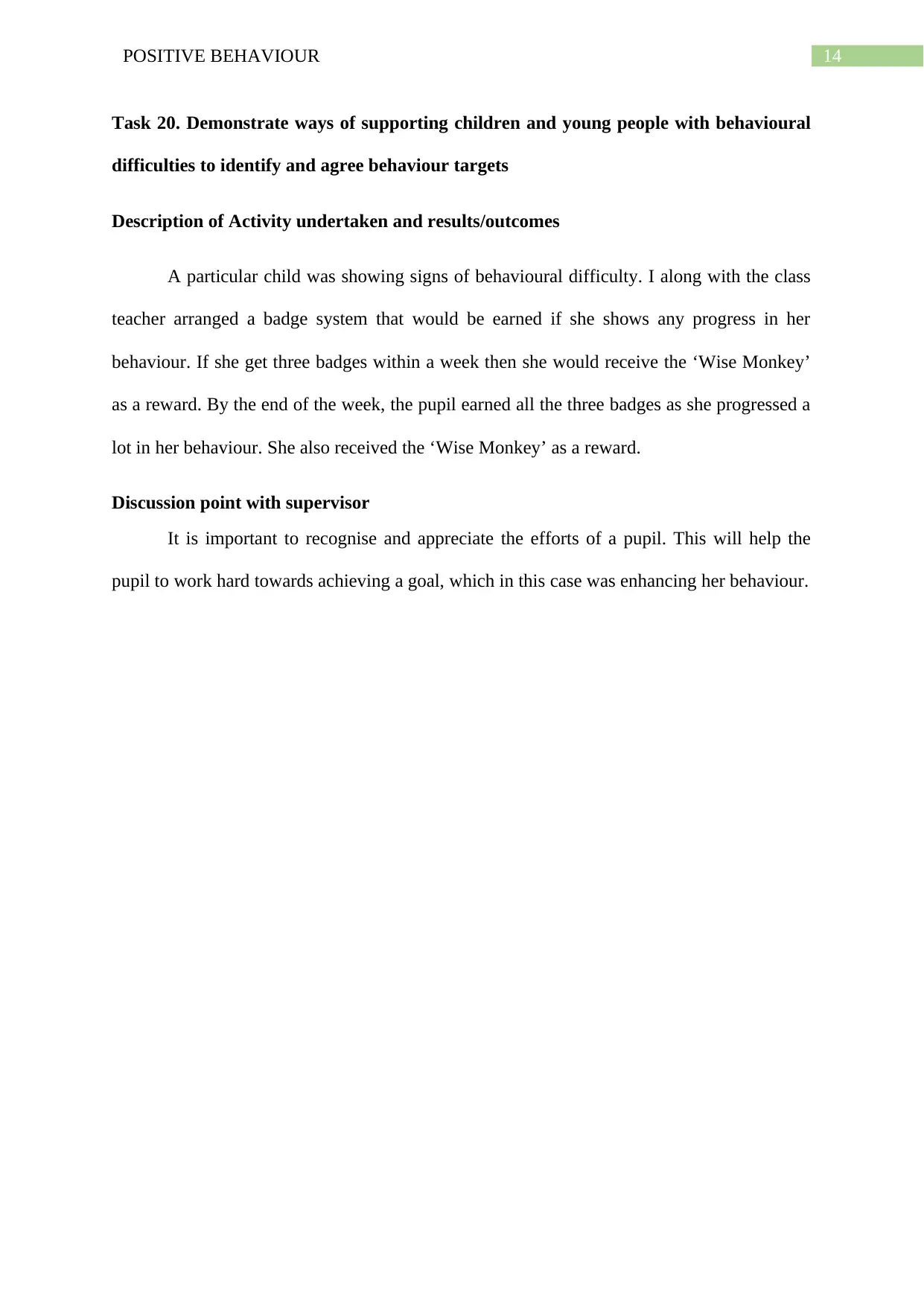
14POSITIVE BEHAVIOUR
Task 20. Demonstrate ways of supporting children and young people with behavioural
difficulties to identify and agree behaviour targets
Description of Activity undertaken and results/outcomes
A particular child was showing signs of behavioural difficulty. I along with the class
teacher arranged a badge system that would be earned if she shows any progress in her
behaviour. If she get three badges within a week then she would receive the ‘Wise Monkey’
as a reward. By the end of the week, the pupil earned all the three badges as she progressed a
lot in her behaviour. She also received the ‘Wise Monkey’ as a reward.
Discussion point with supervisor
It is important to recognise and appreciate the efforts of a pupil. This will help the
pupil to work hard towards achieving a goal, which in this case was enhancing her behaviour.
Task 20. Demonstrate ways of supporting children and young people with behavioural
difficulties to identify and agree behaviour targets
Description of Activity undertaken and results/outcomes
A particular child was showing signs of behavioural difficulty. I along with the class
teacher arranged a badge system that would be earned if she shows any progress in her
behaviour. If she get three badges within a week then she would receive the ‘Wise Monkey’
as a reward. By the end of the week, the pupil earned all the three badges as she progressed a
lot in her behaviour. She also received the ‘Wise Monkey’ as a reward.
Discussion point with supervisor
It is important to recognise and appreciate the efforts of a pupil. This will help the
pupil to work hard towards achieving a goal, which in this case was enhancing her behaviour.
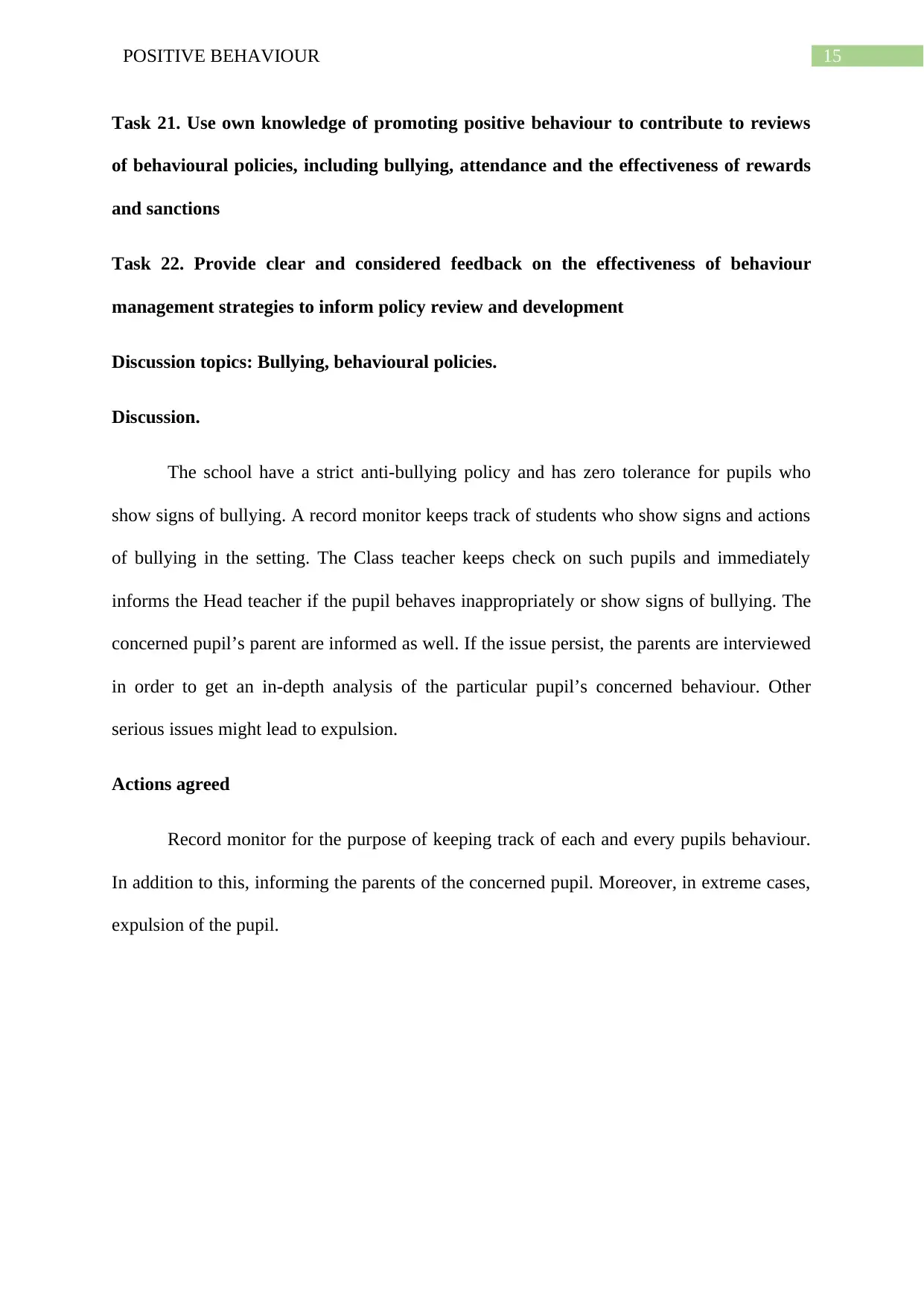
15POSITIVE BEHAVIOUR
Task 21. Use own knowledge of promoting positive behaviour to contribute to reviews
of behavioural policies, including bullying, attendance and the effectiveness of rewards
and sanctions
Task 22. Provide clear and considered feedback on the effectiveness of behaviour
management strategies to inform policy review and development
Discussion topics: Bullying, behavioural policies.
Discussion.
The school have a strict anti-bullying policy and has zero tolerance for pupils who
show signs of bullying. A record monitor keeps track of students who show signs and actions
of bullying in the setting. The Class teacher keeps check on such pupils and immediately
informs the Head teacher if the pupil behaves inappropriately or show signs of bullying. The
concerned pupil’s parent are informed as well. If the issue persist, the parents are interviewed
in order to get an in-depth analysis of the particular pupil’s concerned behaviour. Other
serious issues might lead to expulsion.
Actions agreed
Record monitor for the purpose of keeping track of each and every pupils behaviour.
In addition to this, informing the parents of the concerned pupil. Moreover, in extreme cases,
expulsion of the pupil.
Task 21. Use own knowledge of promoting positive behaviour to contribute to reviews
of behavioural policies, including bullying, attendance and the effectiveness of rewards
and sanctions
Task 22. Provide clear and considered feedback on the effectiveness of behaviour
management strategies to inform policy review and development
Discussion topics: Bullying, behavioural policies.
Discussion.
The school have a strict anti-bullying policy and has zero tolerance for pupils who
show signs of bullying. A record monitor keeps track of students who show signs and actions
of bullying in the setting. The Class teacher keeps check on such pupils and immediately
informs the Head teacher if the pupil behaves inappropriately or show signs of bullying. The
concerned pupil’s parent are informed as well. If the issue persist, the parents are interviewed
in order to get an in-depth analysis of the particular pupil’s concerned behaviour. Other
serious issues might lead to expulsion.
Actions agreed
Record monitor for the purpose of keeping track of each and every pupils behaviour.
In addition to this, informing the parents of the concerned pupil. Moreover, in extreme cases,
expulsion of the pupil.
Secure Best Marks with AI Grader
Need help grading? Try our AI Grader for instant feedback on your assignments.
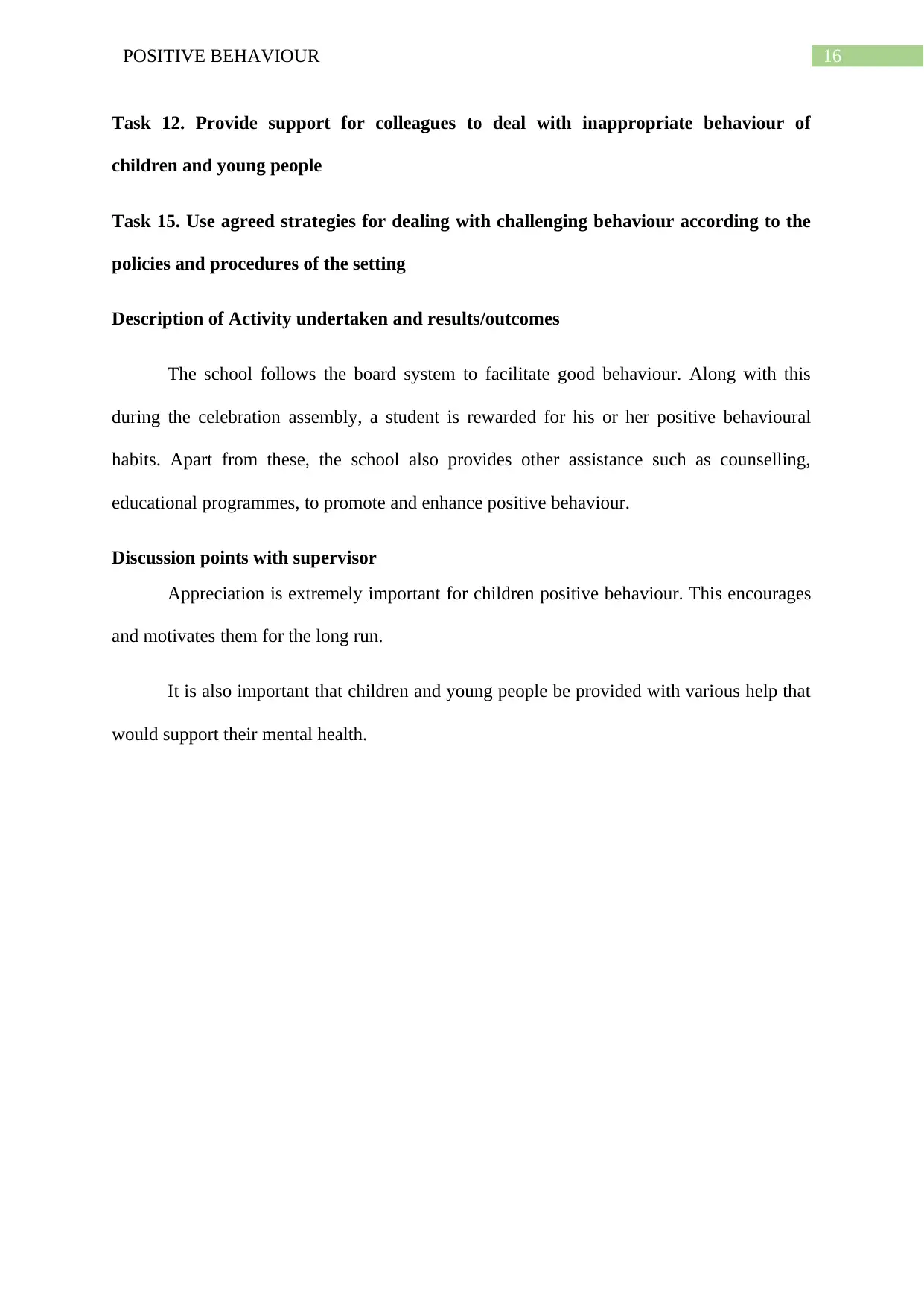
16POSITIVE BEHAVIOUR
Task 12. Provide support for colleagues to deal with inappropriate behaviour of
children and young people
Task 15. Use agreed strategies for dealing with challenging behaviour according to the
policies and procedures of the setting
Description of Activity undertaken and results/outcomes
The school follows the board system to facilitate good behaviour. Along with this
during the celebration assembly, a student is rewarded for his or her positive behavioural
habits. Apart from these, the school also provides other assistance such as counselling,
educational programmes, to promote and enhance positive behaviour.
Discussion points with supervisor
Appreciation is extremely important for children positive behaviour. This encourages
and motivates them for the long run.
It is also important that children and young people be provided with various help that
would support their mental health.
Task 12. Provide support for colleagues to deal with inappropriate behaviour of
children and young people
Task 15. Use agreed strategies for dealing with challenging behaviour according to the
policies and procedures of the setting
Description of Activity undertaken and results/outcomes
The school follows the board system to facilitate good behaviour. Along with this
during the celebration assembly, a student is rewarded for his or her positive behavioural
habits. Apart from these, the school also provides other assistance such as counselling,
educational programmes, to promote and enhance positive behaviour.
Discussion points with supervisor
Appreciation is extremely important for children positive behaviour. This encourages
and motivates them for the long run.
It is also important that children and young people be provided with various help that
would support their mental health.
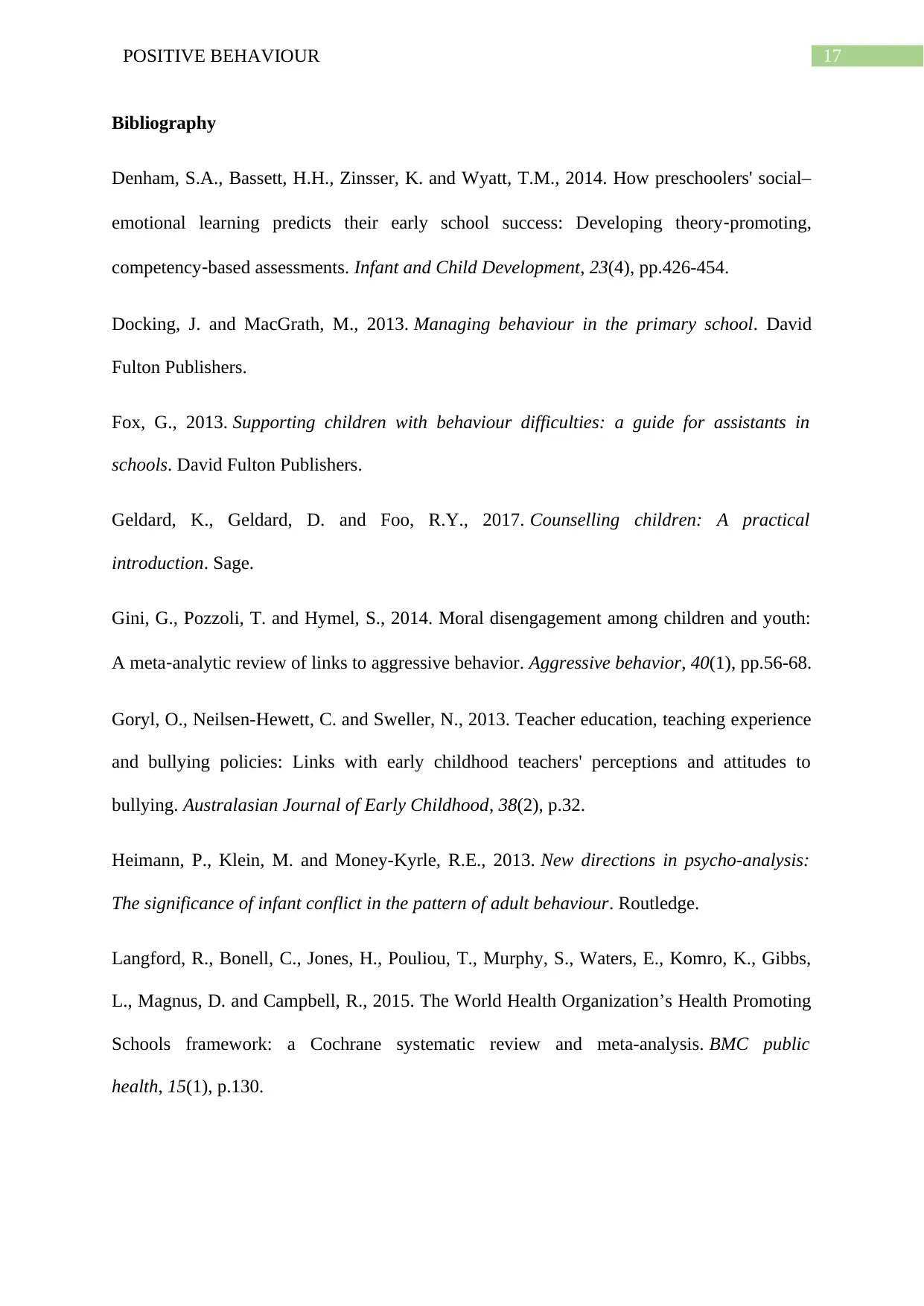
17POSITIVE BEHAVIOUR
Bibliography
Denham, S.A., Bassett, H.H., Zinsser, K. and Wyatt, T.M., 2014. How preschoolers' social–
emotional learning predicts their early school success: Developing theory‐promoting,
competency‐based assessments. Infant and Child Development, 23(4), pp.426-454.
Docking, J. and MacGrath, M., 2013. Managing behaviour in the primary school. David
Fulton Publishers.
Fox, G., 2013. Supporting children with behaviour difficulties: a guide for assistants in
schools. David Fulton Publishers.
Geldard, K., Geldard, D. and Foo, R.Y., 2017. Counselling children: A practical
introduction. Sage.
Gini, G., Pozzoli, T. and Hymel, S., 2014. Moral disengagement among children and youth:
A meta‐analytic review of links to aggressive behavior. Aggressive behavior, 40(1), pp.56-68.
Goryl, O., Neilsen-Hewett, C. and Sweller, N., 2013. Teacher education, teaching experience
and bullying policies: Links with early childhood teachers' perceptions and attitudes to
bullying. Australasian Journal of Early Childhood, 38(2), p.32.
Heimann, P., Klein, M. and Money-Kyrle, R.E., 2013. New directions in psycho-analysis:
The significance of infant conflict in the pattern of adult behaviour. Routledge.
Langford, R., Bonell, C., Jones, H., Pouliou, T., Murphy, S., Waters, E., Komro, K., Gibbs,
L., Magnus, D. and Campbell, R., 2015. The World Health Organization’s Health Promoting
Schools framework: a Cochrane systematic review and meta-analysis. BMC public
health, 15(1), p.130.
Bibliography
Denham, S.A., Bassett, H.H., Zinsser, K. and Wyatt, T.M., 2014. How preschoolers' social–
emotional learning predicts their early school success: Developing theory‐promoting,
competency‐based assessments. Infant and Child Development, 23(4), pp.426-454.
Docking, J. and MacGrath, M., 2013. Managing behaviour in the primary school. David
Fulton Publishers.
Fox, G., 2013. Supporting children with behaviour difficulties: a guide for assistants in
schools. David Fulton Publishers.
Geldard, K., Geldard, D. and Foo, R.Y., 2017. Counselling children: A practical
introduction. Sage.
Gini, G., Pozzoli, T. and Hymel, S., 2014. Moral disengagement among children and youth:
A meta‐analytic review of links to aggressive behavior. Aggressive behavior, 40(1), pp.56-68.
Goryl, O., Neilsen-Hewett, C. and Sweller, N., 2013. Teacher education, teaching experience
and bullying policies: Links with early childhood teachers' perceptions and attitudes to
bullying. Australasian Journal of Early Childhood, 38(2), p.32.
Heimann, P., Klein, M. and Money-Kyrle, R.E., 2013. New directions in psycho-analysis:
The significance of infant conflict in the pattern of adult behaviour. Routledge.
Langford, R., Bonell, C., Jones, H., Pouliou, T., Murphy, S., Waters, E., Komro, K., Gibbs,
L., Magnus, D. and Campbell, R., 2015. The World Health Organization’s Health Promoting
Schools framework: a Cochrane systematic review and meta-analysis. BMC public
health, 15(1), p.130.
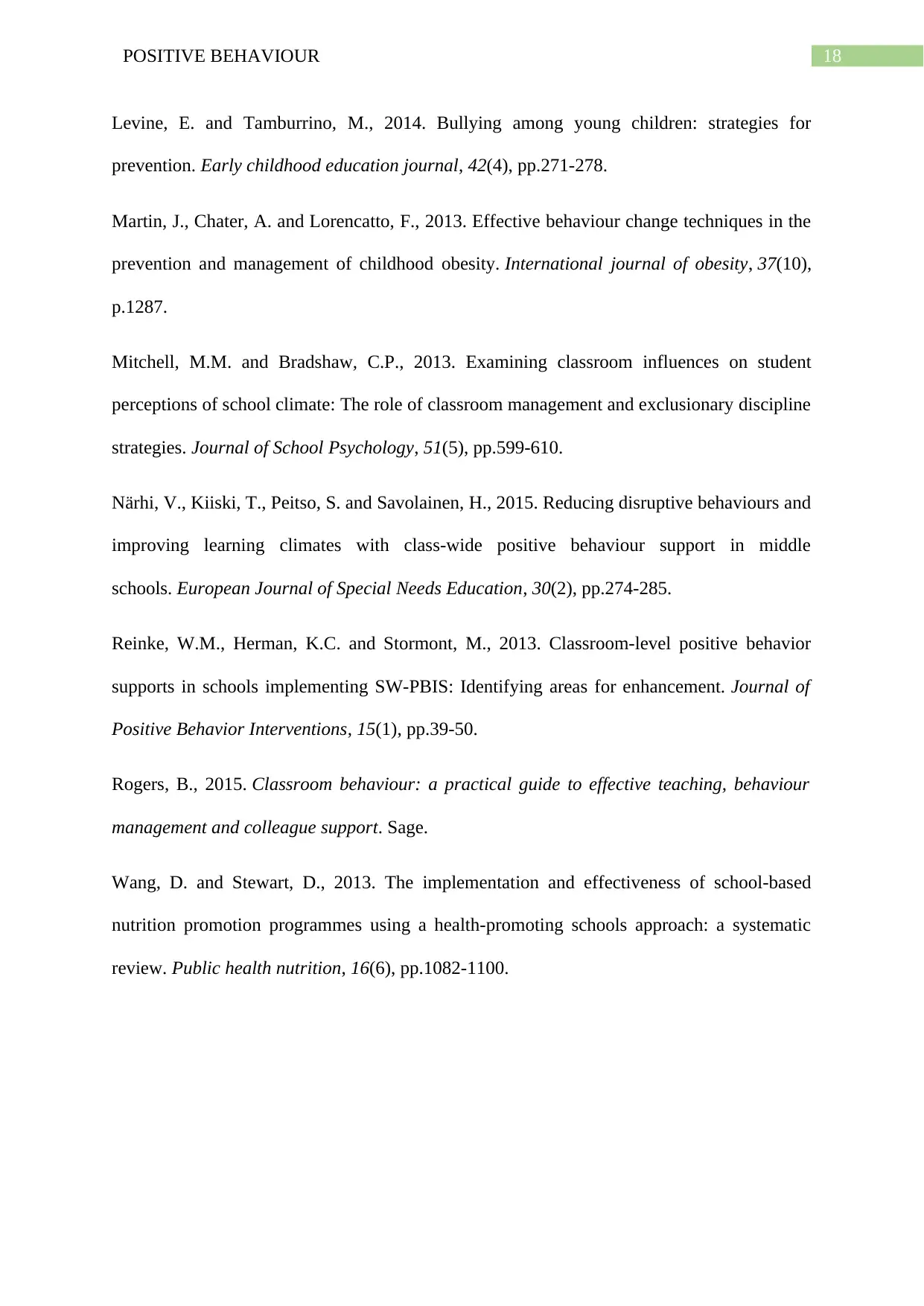
18POSITIVE BEHAVIOUR
Levine, E. and Tamburrino, M., 2014. Bullying among young children: strategies for
prevention. Early childhood education journal, 42(4), pp.271-278.
Martin, J., Chater, A. and Lorencatto, F., 2013. Effective behaviour change techniques in the
prevention and management of childhood obesity. International journal of obesity, 37(10),
p.1287.
Mitchell, M.M. and Bradshaw, C.P., 2013. Examining classroom influences on student
perceptions of school climate: The role of classroom management and exclusionary discipline
strategies. Journal of School Psychology, 51(5), pp.599-610.
Närhi, V., Kiiski, T., Peitso, S. and Savolainen, H., 2015. Reducing disruptive behaviours and
improving learning climates with class-wide positive behaviour support in middle
schools. European Journal of Special Needs Education, 30(2), pp.274-285.
Reinke, W.M., Herman, K.C. and Stormont, M., 2013. Classroom-level positive behavior
supports in schools implementing SW-PBIS: Identifying areas for enhancement. Journal of
Positive Behavior Interventions, 15(1), pp.39-50.
Rogers, B., 2015. Classroom behaviour: a practical guide to effective teaching, behaviour
management and colleague support. Sage.
Wang, D. and Stewart, D., 2013. The implementation and effectiveness of school-based
nutrition promotion programmes using a health-promoting schools approach: a systematic
review. Public health nutrition, 16(6), pp.1082-1100.
Levine, E. and Tamburrino, M., 2014. Bullying among young children: strategies for
prevention. Early childhood education journal, 42(4), pp.271-278.
Martin, J., Chater, A. and Lorencatto, F., 2013. Effective behaviour change techniques in the
prevention and management of childhood obesity. International journal of obesity, 37(10),
p.1287.
Mitchell, M.M. and Bradshaw, C.P., 2013. Examining classroom influences on student
perceptions of school climate: The role of classroom management and exclusionary discipline
strategies. Journal of School Psychology, 51(5), pp.599-610.
Närhi, V., Kiiski, T., Peitso, S. and Savolainen, H., 2015. Reducing disruptive behaviours and
improving learning climates with class-wide positive behaviour support in middle
schools. European Journal of Special Needs Education, 30(2), pp.274-285.
Reinke, W.M., Herman, K.C. and Stormont, M., 2013. Classroom-level positive behavior
supports in schools implementing SW-PBIS: Identifying areas for enhancement. Journal of
Positive Behavior Interventions, 15(1), pp.39-50.
Rogers, B., 2015. Classroom behaviour: a practical guide to effective teaching, behaviour
management and colleague support. Sage.
Wang, D. and Stewart, D., 2013. The implementation and effectiveness of school-based
nutrition promotion programmes using a health-promoting schools approach: a systematic
review. Public health nutrition, 16(6), pp.1082-1100.
Paraphrase This Document
Need a fresh take? Get an instant paraphrase of this document with our AI Paraphraser

19POSITIVE BEHAVIOUR
1 out of 20
Your All-in-One AI-Powered Toolkit for Academic Success.
+13062052269
info@desklib.com
Available 24*7 on WhatsApp / Email
![[object Object]](/_next/static/media/star-bottom.7253800d.svg)
Unlock your academic potential
© 2024 | Zucol Services PVT LTD | All rights reserved.



